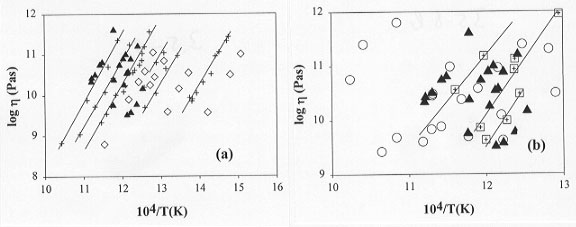

The amount of water dissolved in a silicate melt can strongly influence its physical properties and therefore play an important role in many dynamic volcanological processes like crystallization, degassing, foaming and fragmentation. The aim of this particular study is to characterize the lowering effect of water on the viscosity of an alkaline basalt liquid, in relationship to other differently polymerized hydrous melt compositions. Here we have obtained new data on an Etna lava in order to understand better the eruptive, transport and depositional behavior of the remobilization processes that frequent the Etnean area. The experimental methods used in this preliminary investigation include piston cylinder synthesis of the hydrated products, micropenetration viscometry for low-temperature viscosity measurements, and near-infrared spectroscopy for the evaluation of sample homogeneity and measurement of water content. Sample compositions were determined using the electron microprobe. Results from this study are compared with previous results obtained for trachytic and phonolitic (Fig. 3.5-8a) and for dacitic to rhyolitic-like HPG8 (Fig. 3.5-8b) compositions. We observe that the viscosity of this alkaline basalt, with water contents higher than about 0.5 wt% H2O, is similar to that of alkaline trachyte and is much higher than that of peralkaline phonolites. Additionally, for water contents above 1.5 wt% H2O, the viscosity of the basalt is equivalent to those of the extremely silica rich and highly polymerized melts like HPG8 and Unzen volcano dacite. Finally, we note in Figure 3.5-8a that products like the phonolite (coming from Teide) and the trachyte (coming from the Agnano Monte Spina eruption - Phlegrean Fields), which have about the same silica content and non-bridging oxygens but quite different agpaitic indices, have extremely different viscosity values. This permits us to quantify the effect of individual alkali components on the viscosity of complex natural systems. These results should improve existing models that describe the magmatic processes associated with basaltic flows and, in addition, aid our understanding of the viscous flow mechanism of hydrous silicate melts at the microscopic level.
 |
Fig. 3.5-8: (a) Viscosities plotted as a function of reciprocal temperature for Etna basalt (filled triangles, water content 0.5, 1.03, 1.50 and 2.23 wt% left to right), Teide phonolite (open diamonds, 0.85, 0.95, 2.10 and 3.75) and the Agnano Monte Spina eruption trachyte (crosses, 0.89, 1.12, 1.25, 1.26, 2.04, 2.29, 3.63 and 3.69), and (b) the comparison between the viscosity of the Etna lava with a rhyolite-like composition (HPG 8, open circles, 0.42, 0.97, 1.33, 1.85, and 2.27) and a Unzen dacite (crossed squares, 1.38, 1.64, and 1.98) having a very similar alkali content. |

Tel: +49-(0) 921 55 3700 / 3766, Fax: +49-(0) 921 55 3769, E-mail: bayerisches.geoinstitut(at)uni-bayreuth.de
 Previous page
Previous page